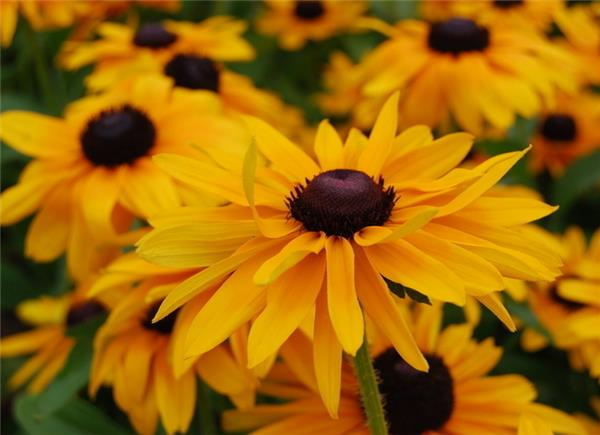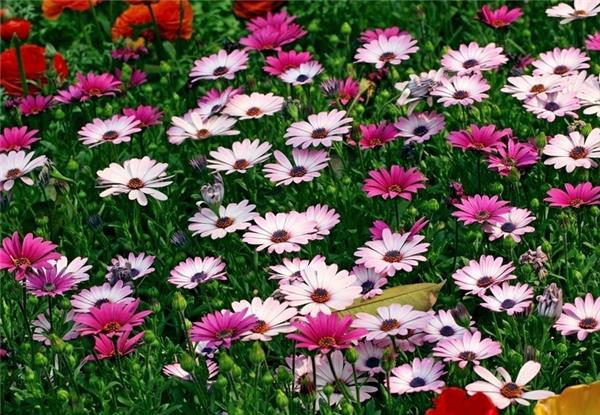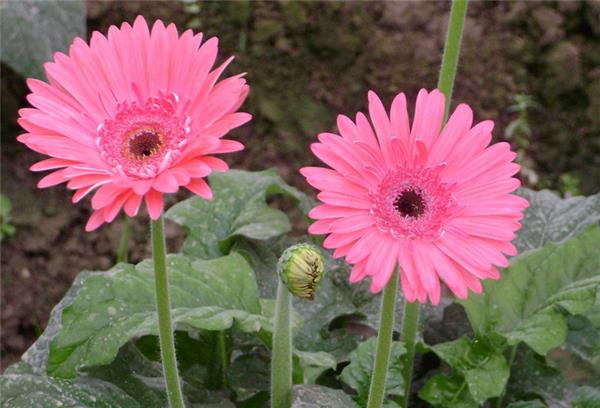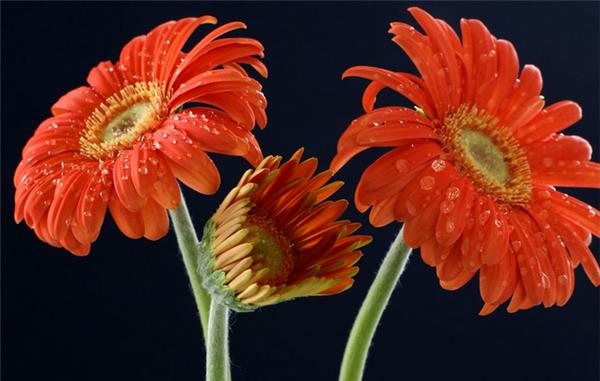Soilless cultivation techniques of African Chrysanthemum
African chrysanthemum is a kind of poetic flower. African chrysanthemum, also known as Fulang flower, symbolizes mutual respect and love, perseverance and no fear of hardship. Today, we would like to introduce the soilless cultivation technology of African chrysanthemum. Let's take a look.

Soilless cultivation techniques of African Chrysanthemum
1. Variety selection
African chrysanthemum is rich in varieties, which can be divided into cut flower varieties and pot varieties according to cultivation methods; according to flower color, they can be divided into red, pink, yellow, white, orange and other varieties; in cut flower cultivation, it is often divided into narrow petal type, wide petal type, double petal type and Gui type according to the width of petals. At present, most of the domestic cultivated varieties are introduced from the Netherlands, and most of them are the Terra series of Terranigra in the Netherlands. The common varieties are Terra-visa, Terra-maxima, Terra-mor, Terra-monza, Terra-cerise of red series, Terra-pastel, Terra-metro, Terra-florida, Terra-queen, Terra-royal of pink series, Terra-mix, Terra-olympic, Terra-sun, Terra-fame, Terra-pmva of yellow series, Terra-mint, Terra-nivalis, Terra-calypso of white series and Terra-corso, Terra-nutans, Terra-kim of orange series.
two。 Cultivation mode and planting
The soilless cultivation of African chrysanthemum can be cultivated by rock wool or other substrates through cultivation bed or pot. The cultivation substrate is usually ceramsite, peat, vermiculite, rice bran, perlite, river sand, sawdust, slag, etc., the cultivation bed is wide 100~120cm, high 25~30cm, paved with bricks.
The planting density of African chrysanthemum should depend on varieties and cultivation patterns. Generally, the planting density is 8 Mel 12 plants / m ~ 2, and the plant-row spacing is about 25cmX35CITI. The planting time is better in spring and autumn, and the climate is suitable to slow down the seedlings. Because after planting in spring, flowers can be produced in the peak season of production and marketing in autumn and winter, so spring planting is more common in production. The planting depth of African chrysanthemum should be as shallow as possible without lodging, and the root neck should be above 1.0~1.5Cm on the surface of the substrate. If the planting is too deep, the root neck and growth point of the seedling are very easy to rot and lead to the death of the seedling. Even after survival, because the growth point is buried in the matrix, the growth and development is easy to be hindered and the flower yield is reduced. If watering and fertilizing improperly, it will cause plant rot and death.

3. Environmental regulation
(1) temperature: in the early stage of planting, higher temperature can promote plant growth. The suitable temperature is about 24 ℃ in the daytime and 21 ℃ in the evening. About 3 weeks later, the temperature was 18: 25 ℃ during the day and 12: 16 C at night to ensure growth and flowering. In autumn and winter, due to the short light time, too high temperature will lead to poor flower quality, the general daytime temperature should be at least 15 ℃, at night should not be lower than 12C, so as to maintain plant growth and flowering. Low temperature of about 5 ℃ in winter can keep the plant alive, but grow slowly and even go into dormancy or semi-dormancy. In short, if the night temperature in winter can be maintained above 1215E and the daily temperature in summer does not exceed 30C, it can blossom all the year round. Temperature regulation can be achieved by means of heating, ventilation, shading and so on, but at the same time, attention should be paid to the change of humidity.
(2) humidity: African chrysanthemum prefers moist substrate and drier air humidity, so it should be fully supplied with water during the growing period. But attention should be paid when watering, do not make the center of the leaves with water, otherwise it is easy to make flower buds rot, especially in hot and muggy weather in summer or slow growth in low temperature in winter. Therefore, African chrysanthemum should be cultivated in shelter from the rain and, if possible, it is best to use drip irrigation facilities to supply water and fertilizer. It is appropriate that the air humidity should not exceed 70% to 80%. If it is too high, it will cause flower deformity and increase the occurrence of diseases. In summer, due to high temperature and strong light, it will often increase the transpiration of plants, resulting in dry soil and lack of water, so water should be replenished in time and shading should be done at the same time. When the temperature drops in autumn, the plant transpiration decreases, but the growth is exuberant, and there is still a large water demand at this time. In winter, plants grow slowly or even enter a dormant or semi-dormant state, so we should pay attention to reduce watering and reduce air humidity. Watering in winter is best carried out in the morning to ensure low air humidity at low temperatures at night.
4. Nutrient solution and its management
Drip irrigation is mostly used to supply nutrient solution and water. Because African chrysanthemum prefers dry air environment, the concentration and supply of nutrient solution that seldom use sprinkler irrigation should be determined according to specific conditions. In the initial stage of planting, the concentration is low and the amount is small, but the concentration is high and the amount is high in the vigorous growth period. The daily fluid supply was 4 to 6 times, with an average of 400~600ml per plant per day.
The pH and ECo of the matrix should be determined regularly and the nutrient solution should be adjusted according to the results. At the initial stage of planting, the EC of nutrient solution is about 1.5mSmax cm; with plant growth, it can be gradually increased to 2.0mSmax cm; in summer, due to the large amount of water evaporation, the concentration of nutrient solution should be reduced appropriately, and the EC should not exceed 2.0mS/cm. In addition, the pH of nutrient solution should be adjusted to about 5.5 ~ 6.5.
In addition, combined with pest control, foliar topdressing can be carried out by spraying 0.1%-0.5% urea, potassium dihydrogen phosphate or low concentration boric acid.

5. Plant management
(1) Leaf stripping: in order to balance the relationship between vegetative growth and reproductive growth, avoid the decline of flower quality caused by excessive vegetative growth, and improve the ventilation and light transmission conditions of the population, leaf peeling is often needed in the production of cut African chrysanthemum. When peeling leaves, we should pay attention to the following aspects: ① first peel off diseased leaves and yellowing aging leaves. The remaining leaves of ② should be evenly distributed to avoid leaf overlap and crossover. Usually, mature plants retain 3-4 ramets, and each ramet has 4 functional leaves. If there are too many densely growing leaflets in the middle of ③ plants, but when there are few functional leaves, some leaflets should be properly removed to control vegetative growth, make flower buds fully visible and promote flower bud development.
(2) Bud thinning: the purpose of bud thinning is to control reproductive growth and improve the quality of cut flowers. First of all, in the seedling stage, in order to ensure plant growth and cultivate nutrients to facilitate the late adult plant flowering, all buds should be removed until the plant has more than 5 functional leaves. Secondly, in order to ensure the quality of cut flowers, some buds should be removed in the flowering stage of adult plants.

6. Pest control
The common diseases of African chrysanthemum are virus disease, blight, powdery mildew, brown spot, and common pests are red spider, leaf miner, whitefly, thrips and so on. Especially viral diseases and red spiders are the most serious.
(1) virus disease: chlorotic ring spots appear on the leaves, some chlorotic spots are oak leaf-like, a few of the disease spots are necrotic, and when the leaves are serious, the leaves become smaller, wrinkled and brittle. Some varieties also showed broken petals, deformed flowers, not bright flowers, and diseased plants were shorter than healthy ones. The pathogen is tobacco fragility virus. The virus is spread by insects and often occurs in patches. Prevention and treatment methods: in the early stage of ①, the diseased leaves or plants were removed in time and taken out of the field and buried or burned, so as to put an end to the source of infection. ② should pay attention to the control of aphids and nematodes and control the spread and spread of diseases.
(2) Red spiders: red spiders are mostly harmed by adults or nymphs absorbing juice on the back of tender leaves and young buds. The leaf edge of the injured tender leaves curled upward, the luster enhanced, the flesh of the leaves became brittle, the petals of the injured petals were brown, shrunk and deformed, and lost their ornamental value. The peak of red spider occurs in May or July-September when the temperature is high and the climate is dry. When the temperature and humidity are high, the harm is significantly reduced. Control method: ① peeled off the injured leaves and buds in time, and concentrated burned o-② and selected acaricides for spray control. Red spiders are easy to develop drug resistance, pesticides should be used alternately.
The remaining leaves of ② should be evenly distributed to avoid leaf overlap and crossover. Usually, mature plants retain 3-4 ramets, and each ramet has 4 functional leaves. If there are too many densely growing leaflets in the middle of ③ plants, but when there are few functional leaves, some leaflets should be properly removed to control vegetative growth, make flower buds fully visible and promote flower bud development.
(2) Bud thinning: the purpose of bud thinning is to control reproductive growth and improve the quality of cut flowers. First of all, in the seedling stage, in order to ensure plant growth and cultivate nutrients to facilitate the late adult plant flowering, all buds should be removed until the plant has more than 5 functional leaves. Secondly, in order to ensure the quality of cut flowers, some buds should be removed in the flowering stage of adult plants.

6. Pest control
The common diseases of African chrysanthemum are virus disease, blight, powdery mildew, brown spot, and common pests are red spider, leaf miner, whitefly, thrips and so on. Especially viral diseases and red spiders are the most serious.
(1) virus disease: chlorotic ring spots appear on the leaves, some chlorotic spots are oak leaf-like, a few of the disease spots are necrotic, and when the leaves are serious, the leaves become smaller, wrinkled and brittle. Some varieties also showed broken petals, deformed flowers, not bright flowers, and diseased plants were shorter than healthy ones. The pathogen is tobacco fragility virus. The virus is spread by insects and often occurs in patches. Prevention and treatment methods: in the early stage of ①, the diseased leaves or plants were removed in time and taken out of the field and buried or burned, so as to put an end to the source of infection. ② should pay attention to the control of aphids and nematodes and control the spread and spread of diseases.
(2) Red spiders: red spiders are mostly harmed by adults or nymphs absorbing juice on the back of tender leaves and young buds. The leaf edge of the injured tender leaves curled upward, the luster enhanced, the flesh of the leaves became brittle, the petals of the injured petals were brown, shrunk and deformed, and lost their ornamental value. The peak of red spider occurs in May or July-September when the temperature is high and the climate is dry. When the temperature and humidity are high, the harm is significantly reduced. Control method: ① peeled off the injured leaves and buds in time, and concentrated burned o-② and selected acaricides for spray control. Red spiders are easy to develop drug resistance, pesticides should be used alternately.
Related
- Wuhan Hospital Iron Tree Blooming Result Was Instantly Frightened by the Gardener Master
- Which variety of camellia is the most fragrant and best? Which one do you like best?
- What is the small blue coat, the breeding methods and matters needing attention of the succulent plant
- Dormancy time and maintenance management of succulent plants during dormancy
- Minas succulent how to raise, Minas succulent plant pictures
- What are the varieties of winter succulent plants
- How to raise succulent plants in twelve rolls? let's take a look at some experience of breeding twelve rolls.
- Attention should be paid to water control for succulent plants during dormant period (winter and summer)
- Watering experience of twelve rolls of succulent plants
- Techniques for fertilizing succulent plants. An article will let you know how to fertilize succulent plants.



